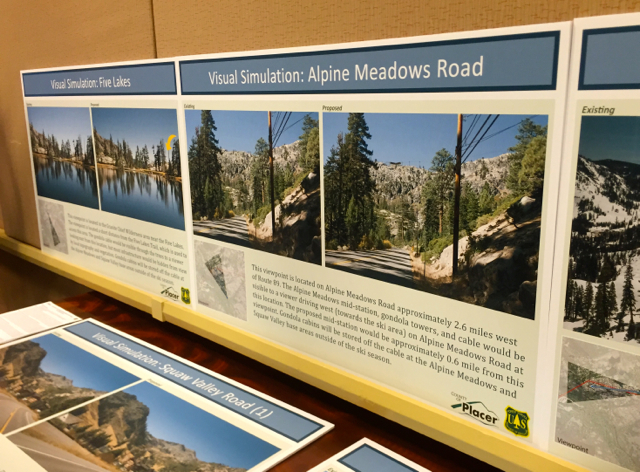Squaw-Alpine gondola project raises questions
By Kathryn Reed
OLYMPIC VALLEY – Planners and landowners must balance recreation, economic development and protection of natural resources as they consider whether to allow the proposed gondola that would link Squaw Valley and Alpine Meadows ski resorts.
Eight members of the public voiced their concerns Monday at the initial scoping meeting for the environmental documents.
Resort owners want to build a gondola that would go from the base of Alpine, have two midstations, and end at the base of Squaw.
(KSL Capital Partners bought Squaw in November 2010. JMA Ventures bought Alpine in 2007. Squaw Valley Ski Holdings Inc. was created in September 2011 to operate both resorts.)
For decades there has been talk of combining the resorts. One of the main stumbling blocks has always been the private landholding. An agreement was reached with Tony Caldwell in April 2015 to have the towers erected on his land near the Granite Chief Wilderness Area.
Building anything so close to a wilderness area is one of the more controversial aspects of the project. While the gondola is designed to only operate during the winter, the towers would always be there. The eight-person cars would be detachable.
Already portions of the two resorts are visible while hiking in the area.

Proponents have images of what the visual impacts may be if the gondola between Squaw and Alpine were built. Photo/LTN
Judy Bruner, who lives part time in Alpine Meadows, questioned the permanent loss of wilderness area if the gondola goes in. Caldwell’s property is technically in the wilderness area, but he was there first. If he were to sell the land and the gondola is there, it could never be wilderness area again.
“I believe the visual quality will forever be impaired,” Bruner said at the May 9 meeting at the Resort at Squaw Creek. Eleven of the 37 towers are slated to be on Forest Service land.
She would like the project proponents to create state-of-the-art modeling to better visualize the impacts.
For Dan Heagerty of the Granite Chief Wilderness Protection League, he worries Placer County will be as receptive to concerns of locals as the agency has been to the Squaw Valley base plan – which in his estimation has been silence.
Resort officials say the gondola will reduce by 100 the number of vehicles on the road between the resorts.
Heagerty challenged that assertion, saying, “This $35 million project is clearly designed to induce visitor visits to both resorts.”
He also brought up the proposed chairlifts in the Alpine master plan and Caldwell’s desires.
Heagerty and others want the gondola project not to be studied in isolation, but with consideration of projects already in the pipeline as well as those being bandied about.
Isaac Silverman, attorney with Sierra Watch, contends some of the lift proposals would not get built without the gondola because the midway station would provide access to them.
Joe Flannery with the Forest Service told people during the breakout session that the assumption is skiers-snowboarders will be able to get off at the midstations. This means new terrain would be accessible via the gondola.
One person asked why a joint EIR-EIS wasn’t being created. No answer was given. The speaker said having to review two documents was more cumbersome for the average person.
Placer County will be dealing with the environmental impact report and California Environmental Quality Act issues. The USFS will handle the environmental impact statement and National Environmental Policy Act requirements.
Comments must be made to both organizations. The feds hope to have the draft EIS done by the end of the year or early 2017, while the county wants the EIR completed sooner.
—–
Notes:
· The project overview is online.
· Comments to Placer County may be emailed to cdraecs@placer.ca.gov. The deadline is May 23.
· Comments to the U.S. Forest Service may be emailed to scoping_comments@squawalpinegondola-eis.com; deadline is May 31.


